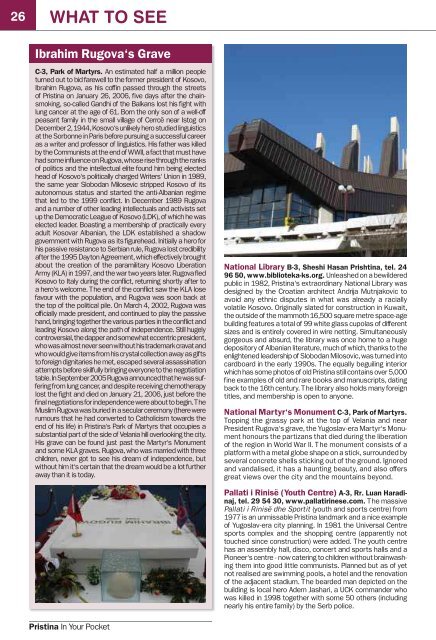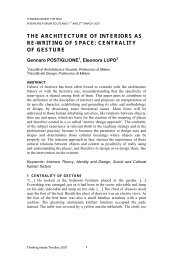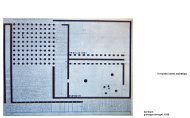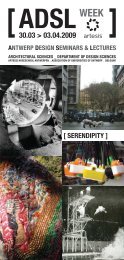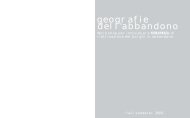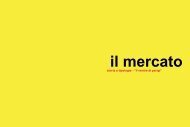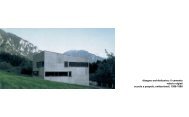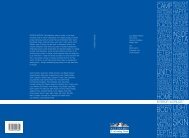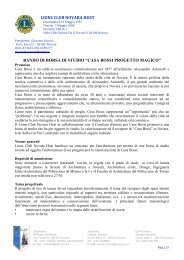Create successful ePaper yourself
Turn your PDF publications into a flip-book with our unique Google optimized e-Paper software.
26<br />
WHAT TO SEE WHAT TO SEE 27<br />
Ibrahim Rugova‘s Grave<br />
C-3, Park of Martyrs. An estimated half a million people<br />
turned out to bid farewell to the former president of Kosovo,<br />
Ibrahim Rugova, as his coffin passed through the streets<br />
of Pristina on January 26, 2006, five days after the chainsmoking,<br />
so-called Gandhi of the Balkans lost his fight with<br />
lung cancer at the age of 61. Born the only son of a well-off<br />
peasant family in the small village of Cerrcë near Istog on<br />
December 2, 1944, Kosovo‘s unlikely hero studied linguistics<br />
at the Sorbonne in Paris before pursuing a successful career<br />
as a writer and professor of linguistics. His father was killed<br />
by the Communists at the end of WWII, a fact that must have<br />
had some influence on Rugova, whose rise through the ranks<br />
of politics and the intellectual elite found him being elected<br />
head of Kosovo‘s politically charged Writers‘ Union in 1989,<br />
the same year Slobodan Milosevic stripped Kosovo of its<br />
autonomous status and started the anti-Albanian regime<br />
that led to the 1999 conflict. In December 1989 Rugova<br />
and a number of other leading intellectuals and activists set<br />
up the Democratic League of Kosovo (LDK), of which he was<br />
elected leader. Boasting a membership of practically every<br />
adult Kosovar Albanian, the LDK established a shadow<br />
government with Rugova as its figurehead. Initially a hero for<br />
his passive resistance to Serbian rule, Rugova lost credibility<br />
after the 1995 Dayton Agreement, which effectively brought<br />
about the creation of the paramilitary Kosovo Liberation<br />
Army (KLA) in 1997, and the war two years later. Rugova fled<br />
Kosovo to Italy during the conflict, returning shortly after to<br />
a hero‘s welcome. The end of the conflict saw the KLA lose<br />
favour with the population, and Rugova was soon back at<br />
the top of the political pile. On March 4, 2002, Rugova was<br />
officially made president, and continued to play the passive<br />
hand, bringing together the various parties in the conflict and<br />
leading Kosovo along the path of independence. Still hugely<br />
controversial, the dapper and somewhat eccentric president,<br />
who was almost never seen without his trademark cravat and<br />
who would give items from his crystal collection away as gifts<br />
to foreign dignitaries he met, escaped several assassination<br />
attempts before skilfully bringing everyone to the negotiation<br />
table. In September 2005 Rugova announced that he was suffering<br />
from lung cancer, and despite receiving chemotherapy<br />
lost the fight and died on January 21, 2006, just before the<br />
final negotiations for independence were about to begin. The<br />
Muslim Rugova was buried in a secular ceremony (there were<br />
rumours that he had converted to Catholicism towards the<br />
end of his life) in Pristina‘s Park of Martyrs that occupies a<br />
substantial part of the side of Velania hill overlooking the city.<br />
His grave can be found just past the Martyr‘s Monument<br />
and some KLA graves. Rugova, who was married with three<br />
children, never got to see his dream of independence, but<br />
without him it‘s certain that the dream would be a lot further<br />
away than it is today.<br />
National Library B-3, Sheshi Hasan Prishtina, tel. 24<br />
96 50, www.biblioteka-ks.org. Unleashed on a bewildered<br />
public in 1982, Pristina‘s extraordinary National Library was<br />
designed by the Croatian architect Andrija Mutnjakovic to<br />
avoid any ethnic disputes in what was already a racially<br />
volatile Kosovo. Originally slated for construction in Kuwait,<br />
the outside of the mammoth 16,500 square metre space-age<br />
building features a total of 99 white glass cupolas of different<br />
sizes and is entirely covered in wire netting. Simultaneously<br />
gorgeous and absurd, the library was once home to a huge<br />
depository of Albanian literature, much of which, thanks to the<br />
enlightened leadership of Slobodan Milosovic, was turned into<br />
cardboard in the early 1990s. The equally beguiling interior<br />
which has some photos of old Pristina still contains over 5,000<br />
fine examples of old and rare books and manuscripts, dating<br />
back to the 16th century. The library also holds many foreign<br />
titles, and membership is open to anyone.<br />
National Martyr‘s Monument C-3, Park of Martyrs.<br />
Topping the grassy park at the top of Velania and near<br />
President Rugova‘s grave, the Yugoslav-era Martyr‘s Monument<br />
honours the partizans that died during the liberation<br />
of the region in World War II. The monument consists of a<br />
platform with a metal globe shape on a stick, surrounded by<br />
several concrete shells sticking out of the ground. Ignored<br />
and vandalised, it has a haunting beauty, and also offers<br />
great views over the city and the mountains beyond.<br />
Pallati i Rinisë (Youth Centre) A-3, Rr. Luan Haradinaj,<br />
tel. 29 54 30, www.pallatirinese.com. The massive<br />
Pallati i Rinisë dhe Sportit (youth and sports centre) from<br />
1977 is an unmissable Pristina landmark and a nice example<br />
of Yugoslav-era city planning. In 1981 the Universal Centre<br />
sports complex and the shopping centre (apparently not<br />
touched since construction) were added. The youth centre<br />
has an assembly hall, disco, concert and sports halls and a<br />
Pioneer‘s centre - now catering to children without brainwashing<br />
them into good little communists. Planned but as of yet<br />
not realised are swimming pools, a hotel and the renovation<br />
of the adjacent stadium. The bearded man depicted on the<br />
building is local hero Adem Jashari, a UCK commander who<br />
was killed in 1998 together with some 50 others (including<br />
nearly his entire family) by the Serb police.<br />
Parks<br />
Gërmia Park. In the hills just east of town, this large<br />
park at the end of bus lines N°4,5 and 9 has a popular<br />
open-air swimming pool that‘s the size of a lake, and endless<br />
forests to ramble through - though you should stick<br />
to the paths which are mine-free. Skiing is possible here<br />
in winter too.<br />
Parku i Qytetit (City park) C-2/3,. East the the centre,<br />
the city park is a pleasant, cleaned-up area with concrete<br />
paths, trees and places to sit and play chess in the shade.<br />
Other sights<br />
Jewish Cemetery Tauk Bahqe hill. The 19th century Jewish<br />
Cemetery on top of Velania‘s Tauk Bahqe dates from the<br />
time that Pristina‘s Jewish community numbered some 1500<br />
souls. It holds about 50 tombstones which are now overgrown<br />
with weeds. After 500 years of presence in Pristina since their<br />
immigration from Spain in 1492, the Jewish community that<br />
remained after the deportations of World War II was forced<br />
to leave in June 1999 and resettled in Belgrade.<br />
Mother Teresa statue B-3, Bul. Nëne Tereza. A small<br />
and humble statue of Mother Teresa, a nun of ethnic Albanian<br />
origin (born in Skopje in what is now Macedonia) who devoted<br />
her life to the poor in India.<br />
Photos of the missing B-2, Bul. Nëne Tereza. A poignant<br />
reminder of the Kosovo crisis, the gates at the northern end<br />
of the street have dozens of photos of Kosovars who have<br />
been missing since the conflict.<br />
Skenderbeu statue B-2, Bul. Nëne Tereza. The monument<br />
of Gjerg j Kastrioti Skenderbeu is the proud new focal<br />
point of Bul. Nëne Tereza, paying homage to the Albanian<br />
superhero who successfully fought in the struggle against<br />
the Ottomans in the fifteenth century. Brightly lit at night and<br />
surrounded by a small plaza, the pedestal seems formed by<br />
a plis, the traditional Albanian egg-shell hat. The statue was<br />
designed by Albanian artist Janaq Paco in 2001.<br />
St. Nicholas Church C-1, Rr. Shkodra. The only active<br />
Serbian Orthodox church in Pristina was damaged by fire during<br />
the 2004 riots. A temporary roof now covers the low 19th<br />
century building and its valuable icon screen from 1840.<br />
Union Hotel building B-2, Bul. Nëne Tereza. Built in<br />
1927, the two-storey former Union Hotel next to the National<br />
Theatre is a typical eclectic building of the early 20th century<br />
that wouldn‘t raise an eyebrow in most Central European<br />
cities, but in Pristina is distinctly different for its dainty decorations.<br />
It currently stands derelict and half empty.<br />
Zahir Pajaziti statue A/B-3, Bul. Nëne Tereza. Opposite<br />
the Grand Hotel, this new statue commemorates Zahir Pajaziti<br />
(1962-1997), a UCK fighter based in the Llapi area. He was killed in<br />
action and is now considered one of the biggest patriots during the<br />
Kosovo crisis - you‘ll always see fresh flowers at the statue.<br />
Around town<br />
Kosovo Heroes Monument. Perhaps the only monument<br />
in the world proudly commemorating an embarrassing defeat<br />
stands about 200 metres off the Pristina-Mitrovica road on the<br />
Kosovo Field (Fushe Kosovo, or Kosovo Polje). The tower built<br />
in 1953 by architect Alexander de Roco for the anniversary of<br />
the 1389 Battle of Kosovo has lost much of its lustre since<br />
the demise of Yugoslavia. Once a symbol of Serb resistance<br />
against the Turks, it was used by Milosevich as a backdrop to<br />
his 1989 speech during the 600th anniversary of the defeat,<br />
rallying the crowds for the Serbian cause - this is when the<br />
weird concrete tubes were added alongside the tower. The UN<br />
soldiers guarding the structure can give an English-language<br />
printout of what you see. You can climb to the top of the tower<br />
for the view of the plateau and the mountains beyond.<br />
Sultan Murad‘s Tomb (Tyrbja e Sulltan Muratit)<br />
Mazgit, 7km west of Pristina. Along the Pristina-Mitrovica<br />
road in Mazgit village, this tomb was built on the spot where the<br />
Turkish Sultan Murad was killed during the 1389 Kosovo Battle.<br />
At first just a plain memorial, a grander mausoleum was erected<br />
in the 19th century. The square building has a porch with domes<br />
that is embellished with Ottoman Baroque decorations, and is<br />
surrounded by a nice garden. The guard can show you inside,<br />
where there‘s a simple coffin-shaped stone with a green cloth<br />
draped over it, and carpets on the floor. There‘s a sign French<br />
about the history of the building. The tomb is the focal point<br />
of the annual St George (Shen Gjerg ji) festival.<br />
Ulpiana. Near Gracanica, excavations revealed the Roman-era<br />
town of Ulpiana, built near the silver and lead mines<br />
that made Kosovo so important for the Roman Empire. The<br />
remains of roads, public and religious buildings have been<br />
found. There‘s not much to see nowadays, though a few<br />
restored 4th-6th century graves can be visited at the city<br />
necropolis.<br />
Pristina In Your Pocket<br />
2006 - 2007


